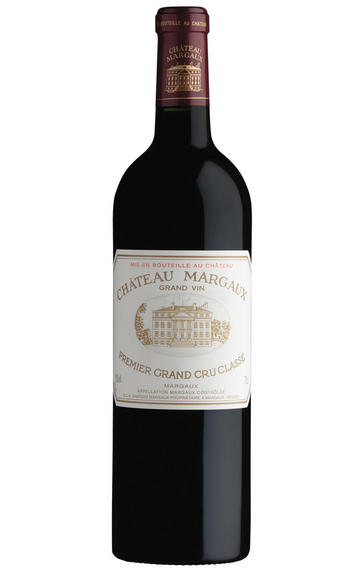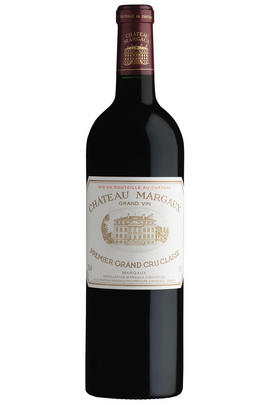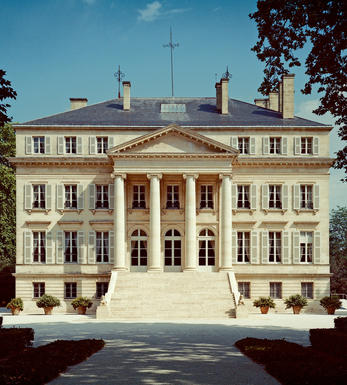
2005 Château Margaux, Margaux, Bordeaux

Critics reviews
In two recent tastings, the 2005 Château Margaux has been nothing less than magnificent. A wine of stunning perfume and inner sweetness, the 2005 gradually opens to reveal layers of red-toned fruit intermingled with floral accents. It's as if all the classic Margaux signatures have been amped up hugely. Dehydration on the vine concentrated the fruit, but also the impression of tannin and acid, such that the 2005 retains huge fruit density along with plenty of brightness as well. Vibrant and beautifully layered, the 2005 Grand Vin is off the charts and easily one of the wines of the vintage. Readers who own it or can find it are in for a real treat. Tasted two times.
Drink 2021 - 2055
Antonio Galloni, Vinous.com (April 2021)
The famed Château Margaux is a 1er cru classé, first growth property, in Bordeaux. The 2005 vintage was heralded as a 5-star year. Château Margaux upped their Cabernet Sauvignon proportion of the blend in 2005 to 85%. If I have to pick my favourite wine from the wonderful 2005 vintage, this one certainly comes very close. Rich plum-purple colours in the glass, just softening around the edges. Attractive just-starting-to-age claret aromas on the nose – liquorice, black truffles and soft black fruits, all carried through onto the palate, have all of the looked-for elements in play. Great plush texture and, a lovely balance of acidity, tannins and fruit, love the complexity and it really lingers on the palate, impressive persistency. Outstanding for me, great Margaux typicity.
Jane Anson, JaneAnson.com
Tasted single blind at Southwold. The crystalline nose here is primal, backward, takes some coaxing from the glass: blackberry, bilberry, briary, graphite and a spellbinding sense of mineralite. The palate is beautifully balanced with svelte tannins. Touches of sandalwood inflecting the pure fruit, deftly integrated new oak; incredible length once again. Despite the vice-like grip on the finish there is a feminine quality to this wine. Quite simply: it takes your breath away. Perfection.
Drink 2015 - 2040+
Neal Martin, Wine Advocate (July 2009)
85% Cabernet Sauvignon, 8% Merlot, 6% Petit Verdot, 1% Cabernet Franc. Following a cold winter, a hot sunny spring led to quick flowering in early June with hot and dry weather during July/August. This led to the development of small, concentrated grapes and a much lower yield than in the cool, damp 2004.
Margaux was undoubtedly one of the stars of the tasting, displaying a massive, monumental structure suggesting this will be a wine to cellar for several decades to come. Lovely purity and concentration on the palate with black fruit surrounding a core of graphite. Although there were delicate floral notes this seemed more Pauillac than Margaux with a cool character on the palate, fine acidity and polished tannins. A very long future ahead. I scored this very highly in 2009 (18.5/20) and felt it was a standout here.
Drink 2023 - 2045
Andy Howard MW, JancisRobinson.com (August 2021)
The nose on this seems more concentrated than the 2000, and the purity of fruit is stunning, with blueberries, raspberries, fresh flowers, and hints of liquorice. This is perfect and complete. Full-bodied, with notes of forest berries and wild raspberries, this is thick and velvety with perfectly polished tannins. You can really feel the density on this, more than the tannic structure. This is a sleeping beauty that will be utterly captivating when it awakes.
Don't touch this until after 2015.
James Suckling, JamesSuckling.com (November 2010)
The first-growth 2005 Chteau Margaux (85% Cabernet Sauvignon, 15% Merlot), a lavish fragrance of blackcurrants, velvety new saddle leather, spring flowers and spice soars from the glass. The wood is already totally concealed beneath the cascade of fruit in this medium to full-bodied, pure and majestic wine. This concentrated, dense, but nevertheless strikingly elegant, multi-layered wine has a finish of 45+ seconds. It builds incrementally to a crescendo and finale. This is a stunner that can be approached already, but promises to be better in another 5-10 years and last at least 25 or more years.
Drink 2020 - 2050
Robert M. Parker, Jr., Wine Advocate (June 2015)
This extraordinary wine announces its brilliance at first glance, with bright curranty fruit aromas that expand quietly at first until one realizes the depth of concentration and flavour it possesses, with exotic spices, smoke, leather, and earth. The blend of 85% Cabernet Sauvignon and 15% Merlot, aged in new casks, produces a silky texture, perfect balance, and enough substance to give fantastic length without any heaviness. This wine was a unanimous favourite in the flight.
Drink 2021 - 2040
Charles Curtis, Decanter.com (June 2021)
Bottled late, in November of 2007.
Saturated red-ruby. Explosive aromas of plum, raspberry, bitter chocolate, coffee, almond paste and smoke; this smells voluptuous. Then extraordinarily opulent on the palate, with an almost marzipan-like ripeness. Coats every square millimetre of the mouth with a texture of liquid silk. The baby fat here is incredible, but there's a structure of steel and powerful minerality underneath. One of the longest samples I tasted in Bordeaux this spring, and a wine with uncanny finishing sweetness. This fabulous vintage of Margaux should evolve positively in bottle for three or four decades in a cold cellar.
"The really important things begin in August, but this year we had bad luck with the weather that month," said director Paul Pontallier. "The vines were continually wet and the foliage kept growing, so in the end we were not able to make a wine with great structure. On the other hand, we did not lose a single berry to mildew." Despite the extended growing season, which featured more than 120 days between the flowering and the harvest, the cabernet franc and petit verdot here did not reach full maturity, Pontallier added. That's the bad news. The good news is that the young 2007 Margaux may well have the purest, most perfumed aromas of the vintage. The selection for the grand vin was a very strict 32%, with another 48% going into the estate's Pavillon Rouge and the remaining 20% of the juice going into a third wine.
Stephen Tanzer, Vinous.com (May 2008)
About this WINE

Chateau Margaux
Château Margaux, a First Growth property, has been owned by the Mentzelopoulos family since 1978. It has since consistently produced some of the finest wines in the Médoc.
One of the grandest, most imposing buildings amongst the Médoc châteaux, Ch. Margaux in its current form was built in the early 19th century, although viticulture had been practised on the estate for several centuries before. A chequered period of ownership in the 19th and early 20th century meant that the quality of some vintages was patchy. But the change which restored the property to its rightful status came in 1977 when it was bought by André Mentzenopoulos, Greek by birth but who had lived in France since 1958 and had made a fortune through supermarket retailing. André immediately instigated much-needed investment in vineyard and cellar. His untimely death in 1980 saw his daughter, Corinne, take up the reins. Corinne’s shrewdest move was the recruitment of talented young winemaker Paul Pontallier to oversee the production.
Paul would lead the estate for 33 vintages. He sadly passed away in 2016. Today, the estate is overseen by director Philippe Bascaules and technical director Sebastien Vergne, working with consultant Eric Boissenot.
The estate has 82 hectares under vine, with Cabernet Sauvignon inevitably dominant (75%) with 20% Merlot making up most of the rest, along with a smattering of Cabernet Franc and Petit Verdot. Unusually in Margaux, there is a white wine made here, Pavillon Blanc, from 100% Sauvignon Blanc, while the two red wines are, of course, Ch. Margaux itself and Pavillon Rouge. Typically, about 30,000 cases of red wine are made, with the Grand Vin usually accounting for just over 40% of the total. Production of the white wine amounts to less than 3,000 cases.
Margaux wines are renowned for their perfumed elegance, but this should not be construed as meaning that these are light-bodied. Far from it, as the best have an enviable structure, layers of complexity, and formidable length.

Margaux
If Pauillac can be seen as the bastion of ‘traditional’ Red Bordeaux, then Margaux represents its other facet in producing wines that are among Bordeaux’s most sensual and alluring. It is the largest commune in the Médoc, encompassing the communes of Cantenac, Soussans, Arsac and Labaude, in addition to Margaux itself. Located in the centre of the Haut-Médoc, Margaux is the closest of the important communes to the city of Bordeaux.
The soils in Margaux are the lightest and most gravelly of the Médoc, with some also containing a high percentage of sand. Vineyards located in Cantenac and Margaux make up the core of the appelation with the best vineyard sites being located on well-drained slopes, whose lighter soils give Margaux its deft touch and silky perfumes. Further away from the water, there is a greater clay content and the wines are less dramatically perfumed.
Margaux is the most diffuse of all the Médoc appelations with a reputation for scaling the heights with irreproachable wines such as Ch. Margaux and Ch. Palmer, but also plumbing the depths, with too many other châteaux not fulfilling their potential. There has been an upward shift in recent years, but the appellation cannot yet boast the reliability of St Julien. However, the finest Margaux are exquisitely perfumed and models of refinement and subtlety which have few parallels in Bordeaux.
Recommended Châteaux: Ch. Margaux, Ch. Palmer, Ch. Brane-Cantenac, Ch. Rauzan-Ségla , Ch. Dufort-Vivens, Ch. Ferrière, Ch. du Tertre, Ch. Giscours, Ch. d'Angludet.

Cabernet Sauvignon Blend
Cabernet Sauvignon lends itself particularly well in blends with Merlot. This is actually the archetypal Bordeaux blend, though in different proportions in the sub-regions and sometimes topped up with Cabernet Franc, Malbec, and Petit Verdot.
In the Médoc and Graves the percentage of Cabernet Sauvignon in the blend can range from 95% (Mouton-Rothschild) to as low as 40%. It is particularly suited to the dry, warm, free- draining, gravel-rich soils and is responsible for the redolent cassis characteristics as well as the depth of colour, tannic structure and pronounced acidity of Médoc wines. However 100% Cabernet Sauvignon wines can be slightly hollow-tasting in the middle palate and Merlot with its generous, fleshy fruit flavours acts as a perfect foil by filling in this cavity.
In St-Emilion and Pomerol, the blends are Merlot dominated as Cabernet Sauvignon can struggle to ripen there - when it is included, it adds structure and body to the wine. Sassicaia is the most famous Bordeaux blend in Italy and has spawned many imitations, whereby the blend is now firmly established in the New World and particularly in California and Australia.


Buying options
Add to wishlist
Description
Words can't convey how good this is. It is an extraordinary Margaux, with a perfume to die for and an astonishing level of concentration and complexity. The tannin levels are the highest ever here but you would never know; they are like velvet on the tongue cloaked with rich, suave and voluptuous forest fruits and crushed raspberries. The finish goes on forever with coffee, mocha and bitter chocolate hints enhancing the intense pure, creamy cassis. This is a classic Margaux that starts slowly and then just builds and builds to a deafening crescendo that engulfs the senses. This is a legendary Margaux.
Berry Bros. & Rudd
wine at a glance
Delivery and quality guarantee